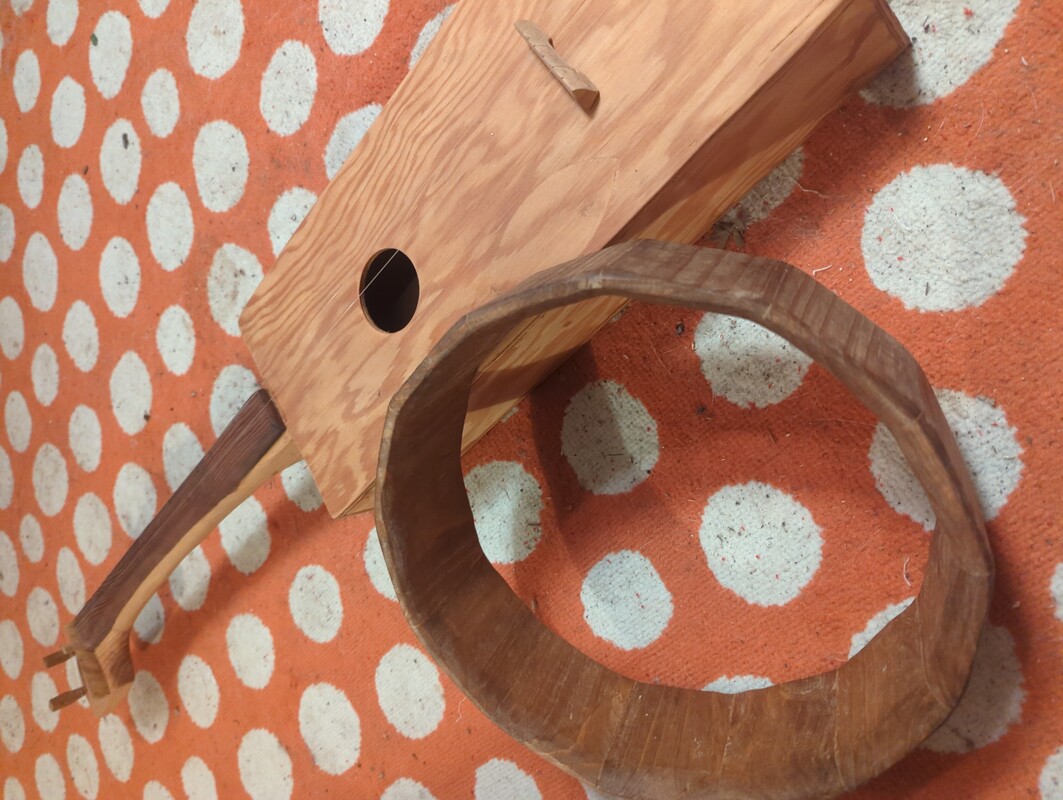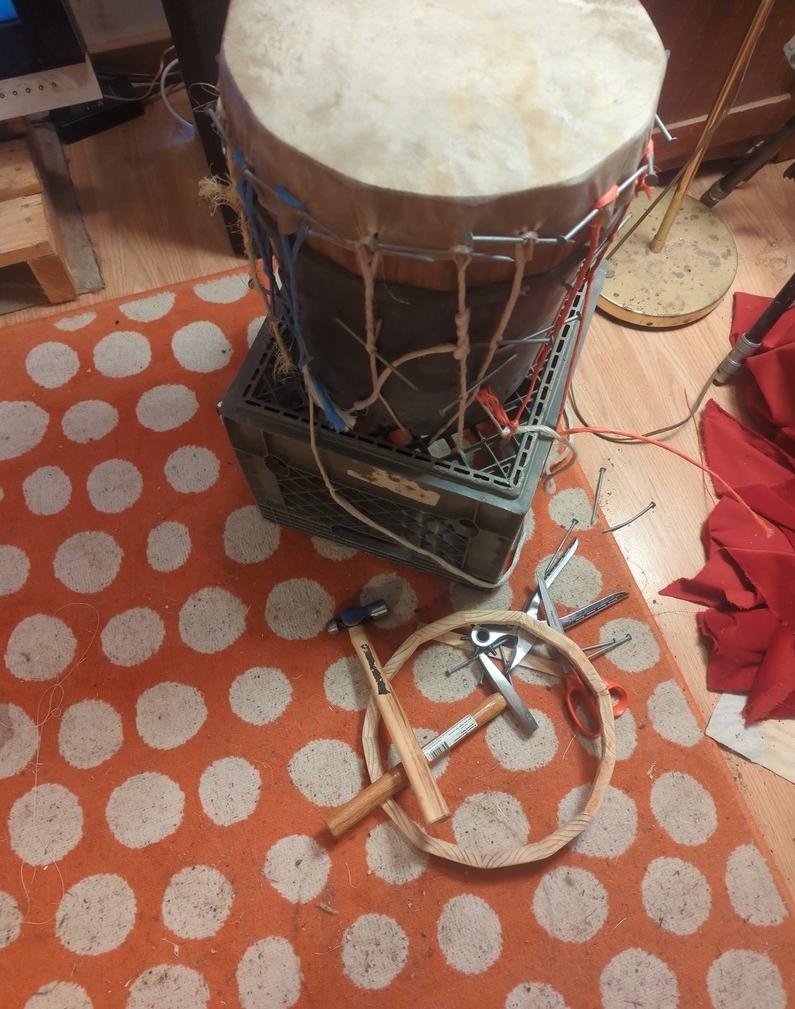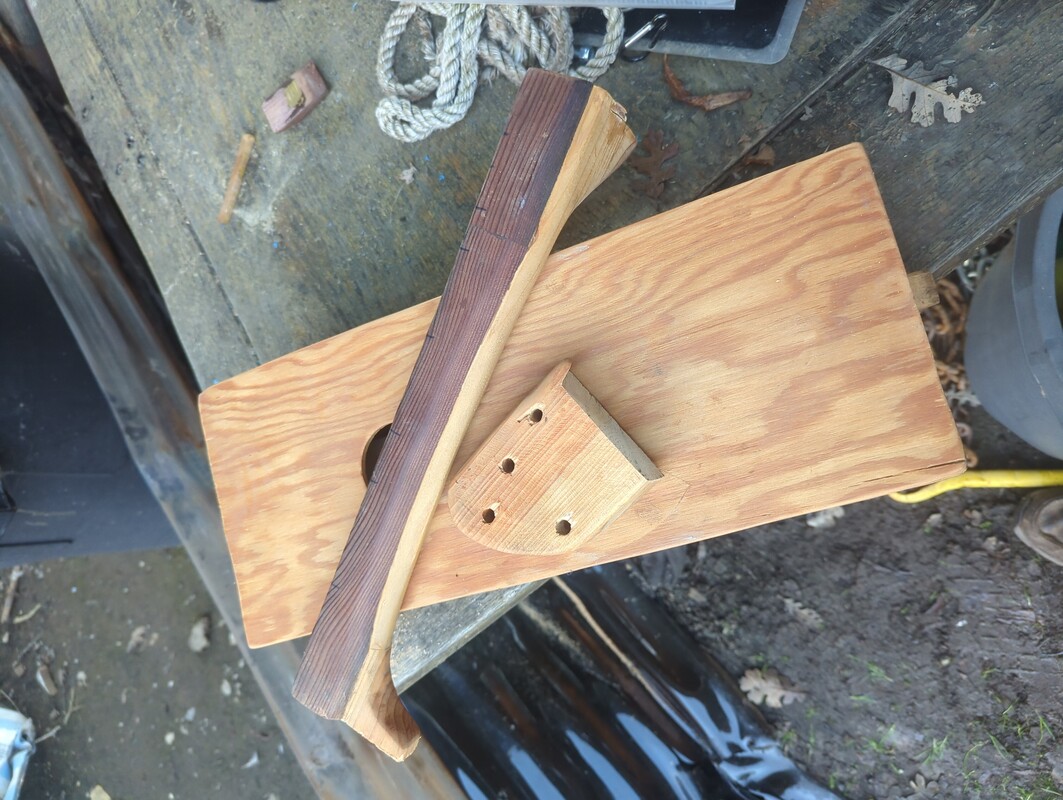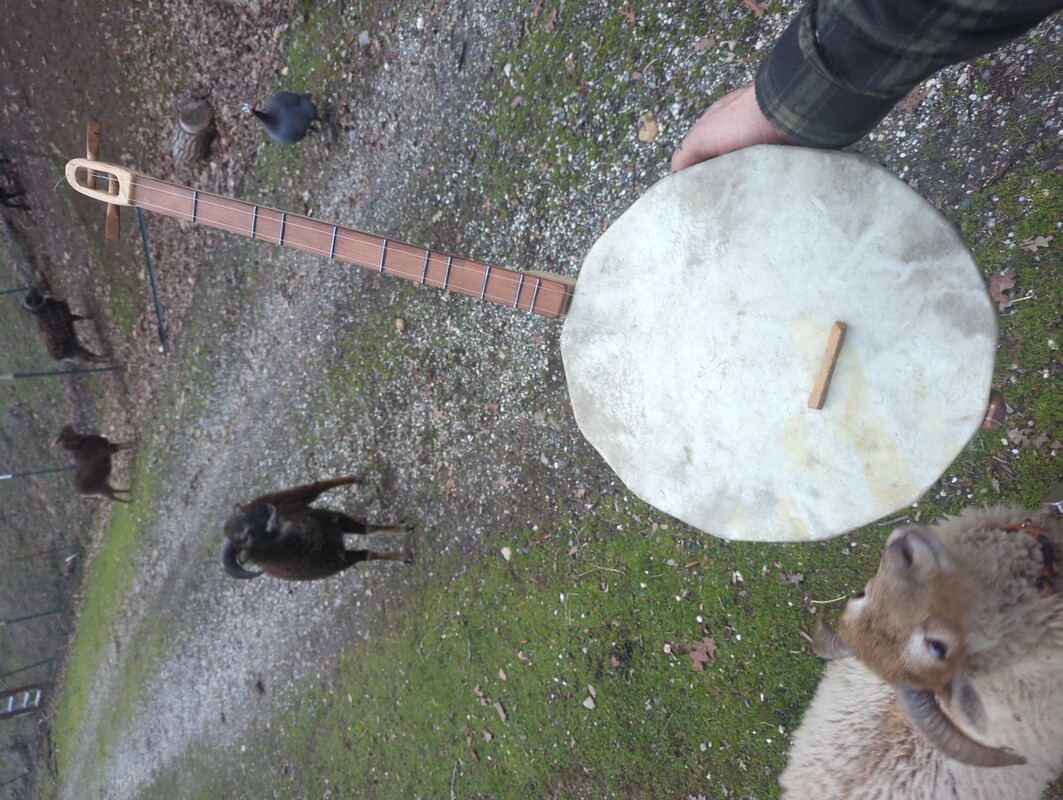Drumbra: a 2 string instrument
The 4 string thing was a lovely experiment that didn't really work for me, and I had been considering 'upcycling' parts of the instrument into a new instrument. One day while creating a new wooden ring in the woodshop, I realized that I already had a few wooden rings that need to be skinned to make a drum.
hmmm… "drum" + "upcycled instrument neck" = "drum dombra thing!" and that settled it, I needed to make a Drumbra.
After making a few dombra tuned instruments, I certainly had an idea for what I wanted to make and it was really just a matter of making some measurement to ensure the components could be sized to my liking. Mostly, I wanted to have the neck be somewhere around 1" wide, and then it was a matter of determining if the combined parts would have a Scale Length that was easy for me to play.
Basic components
 The ring used for this instrument is 13 sided, ½ inch thick, and maybe 2.5" tall. It is soft crappy pine wood. My rough measurements showed
a Scale Length of 21-25 inches. excellent.
The ring used for this instrument is 13 sided, ½ inch thick, and maybe 2.5" tall. It is soft crappy pine wood. My rough measurements showed
a Scale Length of 21-25 inches. excellent.
Stretching the drum head
 A damp piece of sheep skin was cut into a circle and a series of holes was punched around the perimiter of the skin. The skin was placed over the drum
from and long nails were placed in the holes. Cord was wrapped around the nails and then tighted to a crate below the drum frame.
A damp piece of sheep skin was cut into a circle and a series of holes was punched around the perimiter of the skin. The skin was placed over the drum
from and long nails were placed in the holes. Cord was wrapped around the nails and then tighted to a crate below the drum frame.
Once the skin was pulled tight, carpet nails were hammered throught the skin at the top edge of the drum body… and this was a mistake.
Crack, bang, bummer
 What I should have done, is drilled pilot holes first. While hammering in the carpet nails, the drum frame cracked and slit in 4 spots, and the tension of the
drum head make the broken frame splay out.
What I should have done, is drilled pilot holes first. While hammering in the carpet nails, the drum frame cracked and slit in 4 spots, and the tension of the
drum head make the broken frame splay out.
Rapair
 In a mad dash scramble to repair the drum frame before the drum head dried, glue was added to the broken frame pieces and the drum was wrapped with wet rawhide
cord. As the cord dried, it shrank and pulled tightly on the drum frame.
In a mad dash scramble to repair the drum frame before the drum head dried, glue was added to the broken frame pieces and the drum was wrapped with wet rawhide
cord. As the cord dried, it shrank and pulled tightly on the drum frame.
Slay the 4 string thing
 Reused from the 4 string thing, were the neck, head, tuning pegs, bridge, nut, and tail piece. The Neck was cut down to 1" wide and the head was reshaped to
handle just 2 strings.
Reused from the 4 string thing, were the neck, head, tuning pegs, bridge, nut, and tail piece. The Neck was cut down to 1" wide and the head was reshaped to
handle just 2 strings.
Cold day glueing
 The wood glue I used needs to be at least 50°F to work; and outdoor temps were certainly not that warm. Woodcrafting is typically messy and I don't
like working inside, but glue that dries is better than glue that doesn't.
The wood glue I used needs to be at least 50°F to work; and outdoor temps were certainly not that warm. Woodcrafting is typically messy and I don't
like working inside, but glue that dries is better than glue that doesn't.
Spine meets neck
 Too many projects at once. Aside from building the musical instrumennt, at this time I was also busy setting up a new Media playing machine using a Raspberry Pi.
Ideally, the RPi, and a drive of media would have been stuffed into the little jewelry box, but there box was a bit too small.
Too many projects at once. Aside from building the musical instrumennt, at this time I was also busy setting up a new Media playing machine using a Raspberry Pi.
Ideally, the RPi, and a drive of media would have been stuffed into the little jewelry box, but there box was a bit too small.
Finished head and nut
 Once the nut was attached to the head, the instrument was strung in order to test various locations for the bridge. The sweet spot that I found, resulted
in a 58cm Scale Length.
Once the nut was attached to the head, the instrument was strung in order to test various locations for the bridge. The sweet spot that I found, resulted
in a 58cm Scale Length.
Fret measurements
 Fret positions were calculated using https://www.stewmac.com/fretcalculator/ for Dulcimer. The frets are cut
from a piece of welded wire fencing.
Fret positions were calculated using https://www.stewmac.com/fretcalculator/ for Dulcimer. The frets are cut
from a piece of welded wire fencing.
Fret attachment
 The neck was marked for fret placement and then thin shallow grooves were cut across the fingerboard for the frets to rest in. After the glue dried, the frets were
sanded and filed by the neck edges to remove burrs.
The neck was marked for fret placement and then thin shallow grooves were cut across the fingerboard for the frets to rest in. After the glue dried, the frets were
sanded and filed by the neck edges to remove burrs.
Finished Drumbra!
 After stringing and tuning the drumbra, it was time to take the instrument for a spin; and that usually means playing in the sheep pen in the evening.
After stringing and tuning the drumbra, it was time to take the instrument for a spin; and that usually means playing in the sheep pen in the evening.
Playing in the sheep pen
Certainly not the best recording; the guineas and geese tried to steal the spotlight. Silly birds. :D
Cheers,
jezra
